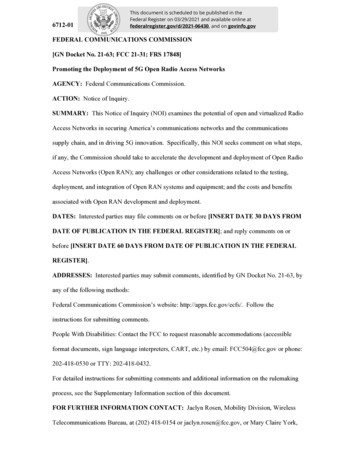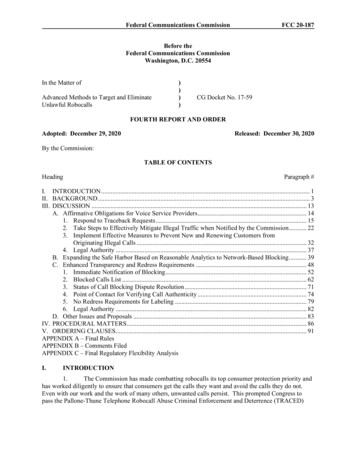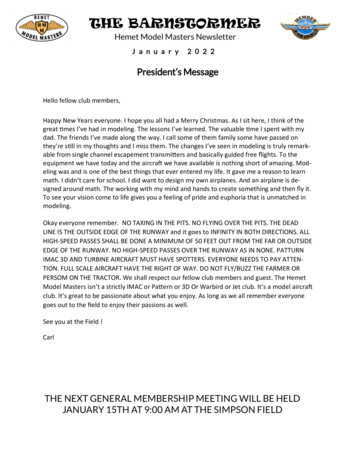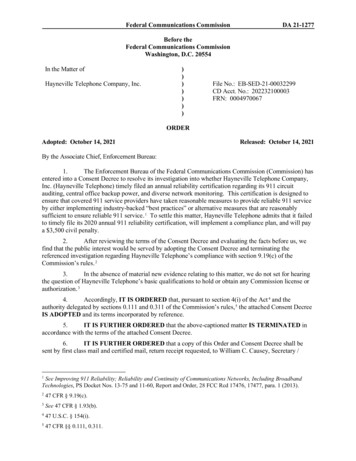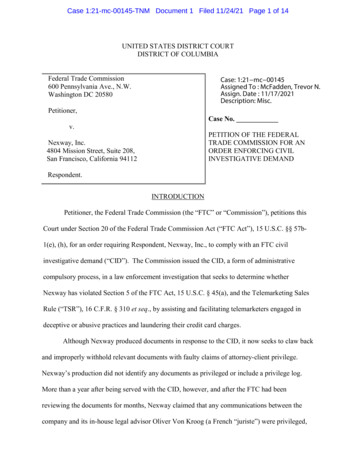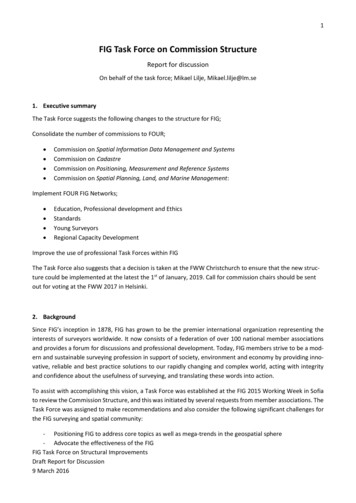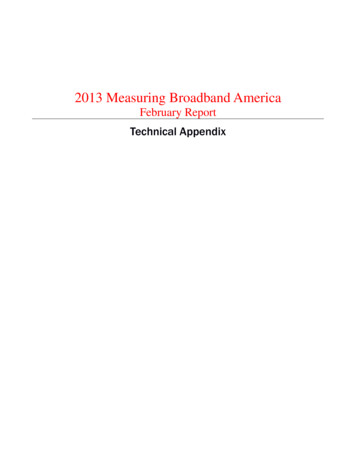
Transcription
2013 Measuring Broadband AmericaFebruary ReportTechnical Appendix
Measuring Broadband AmericaTable of Contents1.2.3.4.Introduction/SummaryPanel ConstructionA.Use of an All Volunteer PanelB.Sample Size and Volunteer SelectionTable 1: ISPs, Sample Sizes and Percentages of Total VolunteersTable 2: Distribution of Whiteboxes by StateTable 3: Distribution of Whiteboxes by Census RegionC.Panelist Recruitment ProtocolD.Validation of Volunteers’ Service TierE.Protection of Volunteers’ PrivacyBroadband Performance Testing MethodologyA.Selection of Hardware ApproachB.Design Principles and Technical ApproachC.Testing Architecturei.Testing Architecture Overviewii.Approach to Testing and Measurementiii.Home Deployment of the NETGEAR Based Whiteboxiv.Home Deployment of the TP-Link Based Whiteboxv.Test Nodes (Off-Net and On-Net)Table 4: Number of Testing Servers Overallvi.Test Node SelectionD.SamKnows MethodologyTable 5: Estimated Total Traffic Volume Generated by TestData Processing and Analysis of Test ResultsA.Backgroundi.Time of Dayii.ISP and Service TierB.Data Collection and Analysis Methodologyi.Data Integrityii.Collation of Results and Outlier Controliii.Peak Hours Adjusted to Local Timeiv.Congestion in the Home Not Measuredv.Traffic Shaping Not Studiedvi.Analysis of PowerBoost and Other ‘Enhancing’ Servicesvii.Latencies Attributable to Propagation Delayviii.Limiting FactorsReference DocumentsUser Terms and ConditionsCode of ConductFEDERAL COMMUNICATIONS COMMISSION FEBRUARY 2013 STATE OF U.S. BROADBAND 2
Measuring Broadband America1. Introduction/SummaryThis Appendix to the 2013 Measuring Broadband America—February Report, A Report on ConsumerWireline Broadband Performance in the U.S., provides detailed technical background information on themethodology that produced the Report.Specifically, this Appendix covers the process by which the panel of consumer participants was originallyrecruited and selected for the August 2011 Report, and then expanded for the July 2012 and February 2013Report; discusses the actual testing methodology; and describes the analysis of the actual test result data.FEDERAL COMMUNICATIONS COMMISSION FEBRUARY 2013 STATE OF U.S. BROADBAND 3
Measuring Broadband America2. Panel ConstructionThis section describes the background to the study and methods employed todesign the target panel, select volunteers for participation, and manage thepanel to maintain the statistical and operational goals of the program.The basic objective of this study was to measure wireline broadband service performance in theUnited States as delivered by an ISP to the consumer’s broadband modem. Many factorscontribute to end-to-end broadband performance, only some of which are under the control ofthe consumer’s ISP. Although there are several ways to measure broadband performance, themethodology outlined here is focused on the measurement of broadband performance within thescope of an ISP’s network, and specifically focuses on measuring performance from theconsumer Internet access point, or consumer gateway, to a close major Internet gateway point.The design of the methodology allows it to be integrated with other technical measurementapproaches that, in the future, could focus on other aspects of broadband performance.A.Use of an All Volunteer PanelIn 2008, SamKnows 1 conducted a test of residential broadband speed and performance in theUnited Kingdom 2 and during the course of that test determined that attrition rates for such a testwere lower when an all-volunteer panel was used, rather than attempting to maintain a panelthrough an incentive scheme of monthly payments. Consequently, in designing themethodology for this broadband performance study, the Commission relied entirely on volunteerconsumer broadband subscribers. The volunteers were selected from a large pool ofprospective participants according to a plan designed to generate a representative sample ofdesired consumer demographics, including geographical location, ISP, and speed tier. As anincentive for participation, volunteers were given access to a personal reporting suite whichallowed them to monitor the performance of their broadband service. They were also providedwith a measurement device referred to in the study as a “Whitebox,” configured to run customSamKnows software. 3B.Sample Size and Volunteer SelectionThe study allowed for a target deployment of up to 10,000 Whiteboxes to volunteer panelistsacross the United States. The number of volunteers from each participating broadband providerwas selected to ensure that the data collected would support statistically valid inferences based ona first order analysis of gathered data. Other methodological factors and considerations thatinfluenced the selection of the sample size and makeup included: 123The panel of U.S. broadband subscribers was drawn from a pool of over 145,000 volunteersfollowing an ongoing recruitment campaign that ran from May 2010 through September 2012.SamKnows is a company that specializes in broadband availability measurement and was retained under contract by the FCCto assist in this study. See http://www.samknows.com/broadband/index.php.See http://www.samknows.com/broadband/pm/PM Summer 08.pdf (last accessed February 1, 2013).The Whiteboxes remain in consumer homes and continue to run the tests described below. Participants may remain in thetrial as long as it continues, and may retain their Whitebox when they end their participation.FEDERAL COMMUNICATIONS COMMISSION FEBRUARY 2013 STATE OF U.S. BROADBAND 4
Measuring Broadband America The volunteer sample was organized with a goal of covering major ISPS in the 48 contiguousstates across five broadband technologies: DSL, cable, fiber-to-the-home, fixed terrestrialwireless, and satellite. 4 Target numbers for volunteers were also set across the four Census Regions—Northeast,Midwest, South and West—to help ensure geographic diversity in the volunteer panel andcompensate for network variances across the U.S. 5 Each of the four Census Regions was split into three speed ranges: 3 Megabits per second(Mbps), 3 10 Mbps, 10 Mbps, 6 with each speed tier forming an individual sample ‘cell’against which a target number of volunteers would be selected. 7 A target plan for allocation of Whiteboxes was developed based on the market share ofparticipating ISPs. Initial market share information was based principally on FCC Form477 8 data filed by participating ISPs for June 2011. An initial set of prospective participants was selected from volunteers who had respondeddirectly to SamKnows as a result of media solicitations. Where gaps existed in the statisticalsample plan, SamKnows worked with participating ISPs via email solicitations targeted atunderrepresented cells. A miscellaneous cell was created across cable, fiber-to-the-home,DSL, and satellite technologies, and across all regions and service tiers, to allow additionalunits to be allocated to accommodate volunteers who did not fit into other cells or whochanged ISPs or service tiers during the trial. Statistical experts from both the FCC and the ISPs reviewed and agreed to the plan.Prior to the September 2012 testing period, 6,635 panelists from the July 2012 sample continuedto supply data via their measurement devices. In addition, 405 subscribers were recruited afterthe July 2012 testing period, which brought the total subscribers reporting data in September 2012to 7,040. After the data were processed, as discussed in more detail below, test results from atotal of 6,733 panelists were used in the September 2012 Report.45678The final results included volunteers from 49 states and the District of Columbia (there were no Whiteboxes in Alaska).Results collected from consumers’ Whiteboxes using some satellite and fixed terrestrial wireless technologies with lownumber of volunteers were not included in the report. However, data collected from those satellite and fixed terrestrialwireless subscribers are included in the detailed data files released to the public in the Raw Bulk Data Set.Although the Commission’s volunteer recruitment was guided by Census Region to ensure the widest possible distribution ofpanelists throughout the United States, as discussed below an insufficient number of testing devices were deployed toenable the evaluation of regional differences in broadband performance.These speed ranges were chosen to provide alignment with broadband tiers as categorized in the “Form 477” reports that theCommission uses as its primary tool for collecting data about broadband networks and services. See Modernizing the FCCForm 477 Data Program, Notice of Proposed Rulemaking, 26 FCC Rcd 1508, 1512 n.27 (2011), citing Development ofNationwide Broadband Data to Evaluate Reasonable and Timely Deployment of Advanced Services to All Americans, Improvement ofWireless Broadband Subscribership Data, and Development of Data on Interconnected Voice over Internet Protocol (VoIP) Subscribership,Report and Order and Further Notice of Proposed Rulemaking, 23 FCC Rcd 9691, 9700-01 (2008).The term cell is used to describe a specific number associated with a set of volunteer attributes (ISP, technology, region, speedtier) that provided a specific sample set of volunteers for the population.FCC Form 477 data collects information about broadband connections to end user locations, wired and wireless .fcc.gov/form477/inst.htm# PURPOSE for further information.FEDERAL COMMUNICATIONS COMMISSION FEBRUARY 2013 STATE OF U.S. BROADBAND 5
Measuring Broadband AmericaThe recruitment campaign resulted in the coverage needed to ensure balanced representation ofusers across the U.S. Table 1 presents the number of volunteers for the month of September2012 listed by ISP, as well as the percent of total volunteers accounted for by each ISP.Table 1ISPs, Sample Sizes and Percentages of Total VolunteersISPSample size% of total L COMMUNICATIONS COMMISSION FEBRUARY 2013 STATE OF U.S. BROADBAND 6
Measuring Broadband AmericaThe distribution of Whiteboxes by state is found in Table 2. 9Table 2Distribution of Whiteboxes by StateStateTotalBoxes% % of TotalU.S.BroadbandSubscribersin State %StateTotalBoxes% TotalBoxes% of TotalU.S.BroadbandSubscribersin 1.8%7.1%0.8%2.6%0.2%2.3%1.9%0.5%0.2%Subscriber data in the February 2013 Report is based on the FCC’s Internet Access Services Report with data current to June30, 2011. See Internet Access Services: Status as of June 30, 2011, Wireline Competition Bureau, Industry Analysis andTechnology Division (rel. June 2012), available at http://fjallfoss.fcc.gov/edocs public/attachmatch/DOC-314630A1.pdf.10The percentages were calculated as a percent of the total 78,900 subscriptions of each state. See id., Table 16 ResidentialFixed Connections and Households by State as of June 30, 2011 (Connections over 200 kbps in at least one direction andhouseholds, in thousands) at 36.9FEDERAL COMMUNICATIONS COMMISSION FEBRUARY 2013 STATE OF U.S. BROADBAND 7
Measuring Broadband AmericaThe distribution of Whiteboxes by Census Region is found in Table 3.Table 3C.Distribution of Whiteboxes by Census RegionCensus RegionTotal Boxes% Total Boxes% of Total 179126%21%South215631%35%West180026%23%Panelist Recruitment ProtocolPanelists were recruited in the 2011 and 2012 panels using the following method: A significant proportion of volunteers were recruited via an initial public relations and socialmedia campaign led by the FCC. This included discussion on the FCC website and ontechnology blogs, as well as articles in the press regarding the study. The demographics of this initial panel were reviewed to identify any deficiencies with regardto the sample plan described above. These goals were set to produce statistically valid setsof volunteers for demographics based on ISP, speed tier, technology type, and region. Thisinitial pool of volunteers was then supplemented by the participating ISPS, who sent out anemail to customers in desired demographics that were under-represented in the pool ofpublicly-solicited volunteers. Emails directed interested volunteers to contact SamKnowsregarding participation in the trial. At no time during this recruitment process did the ISPShave any knowledge regarding which of their customers might be participating in the trial.In almost all cases, ISP engagement in soliciting volunteers enabled us to meet desireddemographic targets.The mix of panelists recruited using the above methodologies varied by ISP.A multi-mode strategy was used to qualify volunteers for this trial.process were as follows:The key stages of this1. Volunteers were directed to complete an online form, which provided information on thestudy and required volunteers to submit a small amount of information, which was used totrack subsequent submissions by these volunteers.FEDERAL COMMUNICATIONS COMMISSION FEBRUARY 2013 STATE OF U.S. BROADBAND 8
Measuring Broadband America2. Those volunteers who were determined to be representative of the target broadband userpopulation were sent a follow-up email, which invited participation in a web-based speed testthat was developed by SamKnows in collaboration with Measurement Lab (“M-Lab”) andPlanetLab. 113. Volunteers were selected from respondents to this follow-up email based on the statisticalrequirements of the panel. Selected volunteers were then asked to complete anacknowledgment of User Terms and Conditions that outlined the permissions to be grantedby the volunteer in key areas such as privacy. 124. Of those volunteers that completed the User Terms and Conditions, SamKnows selected thefinal panel of 12,000 participants, 13 each of whom received a Whitebox for self-installation.SamKnows provided full support during the Whitebox installation phase.The graphic below illustrates the study recruitment methodology:111213M-Lab is a consortium supporting research on broadband networks. PlanetLab is a global research network supporting thedevelopment of new network services.More information on M-Lab and PlanetLab can be found athttp://www.measurementlab.net and http://planet-lab.org, respectively.The User Terms and Conditions is found in the Reference Documents at the end of this Appendix.Over 12,000 Whiteboxes have been shipped to targeted volunteers since 2011, of which 7,040 were online and reporting datain September 2012, with data from 6,733 subscribers ultimately used in the validated data set on which the February 2013Report is based.FEDERAL COMMUNICATIONS COMMISSION FEBRUARY 2013 STATE OF U.S. BROADBAND 9
Measuring Broadband AmericaD.Validation of Volunteers’ Service TierThe methodology employed in this study included verifying each panelist’s service tier and ISPagainst the record base of participating ISPs. 14 Initial throughput tests were used to confirmreported speeds.The broadband service tier reported by each panelist was authenticated in the following way: At the time of recruitment, each panelist was required to complete a speed test using an MLab server. This test provided a rough approximation of the panelist’s service tier whichserved to identify panelists with targeted demographics, and highlighted anomalies in thepanelist’s survey response to measured speed. At the time the panelist installed the Whitebox, the device automatically ran an IP test tocheck that the ISP identified by the volunteer was correct. The Whitebox also ran an initial test which flooded each panelist’s connection in order toaccurately detect the throughput speed when their deployed Whitebox connected to a testnode. Each ISP was asked to confirm the broadband service tier reported by each selected panelist. SamKnows then took the validated speed tier information that was provided by the ISPS andcompared this to both the panelist-provided information, and the actual test results obtained,in order to ensure accurate tier validation.SamKnows manually completed the following four steps for each panelist: Verified that the IP address was in a valid range for those served by the ISP in question. Reviewed data for each panelist and removed data where speed changes such as tier upgradeor downgrade appeared to have occurred, either due to a service change on the part of theconsumer or a network change on the part of the ISP. Identified panelists whose throughput appeared inconsistent with the provisioned service tier.Such anomalies were re-certified with the consumer’s ISP. 15 Verified that the resulting downstream-upstream test results corresponded to the ISPprovided speed tiers, and updated accordingly if required.The February 2013 report includes, for the first time, services from a satellite operator (ViaSat).Historically measuring satellite performance has been troublesome, because fundamental1415Past FCC studies found that a high rate of consumers could not reliably report information about their broadband service,and the validation of subscriber information ensured the accuracy of advertised speed and other subscription details againstwhich observed performance was measured. See John Horrigan and Ellen Satterwhite, Americans’ Perspectives on C2010),availableathttp://hraunfoss.fcc.gov/edocs public/attachmatch/DOC-298516A1.doc (finding that eighty percent of broadbandconsumers did not know what speed they had purchased).For example, when a panelist’s upload or download speed was observed to be significantly higher than that of the rest of thetier, it could be inferred that a mischaracterization of the panelist’s service tier had occurred. Such anomalies, when notresolved in cooperation with the service provider, were excluded from the February 2013 Report, but will be included in theRaw Bulk Data Set.FEDERAL COMMUNICATIONS COMMISSION FEBRUARY 2013 STATE OF U.S. BROADBAND 10
Measuring Broadband Americadifferences in the technology required a different way of measuring user experience. However,recent advances in satellite broadband technology have meant it is now possible to measure theseservices in the same fashion as wireline technologies. Satellite broadband services often includeusage caps as part of the subscription agreement, which could make the testing being conductedunder this program unviable, as the testing alone would exhaust the users’ usage allowances. Inorder to allow testing to be conducted on-par with fixed-line services, an agreement wasestablished with ViaSat whereby the usage caps would be increased for the panelists for theduration of the testing.Of the more than 12,000 Whiteboxes that were shipped to panelists since 2011, 7,040 16 unitswere reporting data in September 2012. The participating ISPs validated 78 percent of thesepanelists, of which 9 percent were reallocated to a different tier following the steps listed above.The remaining 22 percent of panelists were validated based on comparing the performance dataand line performance characteristics with the available service tiers from the appropriate ISP.Eliminating panelists who either changed ISPs during the month of September 2012 or did notproduce data for this trial during that month produced the final data set of the approximately6,733 volunteers included in the February 2013 Report.E.Protection of Volunteers’ PrivacyA major concern during this trial was to ensure that panelists’ privacy was protected. The panelwas comprised entirely of volunteers who knowingly and explicitly opted-in to the testingprogram. Full opt-in documentation was preserved in confidence for audit purposes.All personal data was processed in conformity with relevant U.S. law and in accordance withpolicies developed to govern the conduct of the parties handling the data. The data wereprocessed solely for the purposes of this study and are presented here and in all online data setswith all personally identifiable information (PII) removed.To fulfill these privacy requirements a range of materials was created both to inform each panelistregarding the details of the trial, and to gain the explicit consent of each panelist to obtainsubscription data from the participating ISPs. These documents were reviewed by the Office ofGeneral Counsel of the FCC and the participating ISPs and other stakeholders involved in thestudy.16This figure represents the total number of boxes reporting during September 2012, the month chosen for the February 2013Report. Shipment of boxes continued in succeeding months and these results will be included in Raw Bulk Data Set.FEDERAL COMMUNICATIONS COMMISSION FEBRUARY 2013 STATE OF U.S. BROADBAND 11
Measuring Broadband America3. Broadband Performance Testing MethodologyThis section describes the system architecture and network programmingfeatures of the tests, and other technical aspects of the methods employed tomeasure broadband performance during this study.A.Selection of Hardware ApproachA fundamental choice when developing a solution to measure broadband performance is whetherto use a hardware or software approach.Software approaches are by far the most common and allow a very large sample to be reachedrelatively easily. Web-based speed tests fall into this category. These typically use Flash or Javaapplets, which execute within the context of the user’s web browser. When initiated, theseclients download content from remote web servers and measure the throughput of the transfer.Some web-based speed tests also perform upload tests, while others perform basic latency checks.Other less common software-based approaches to performance measurement involve installingapplications on the user’s workstation which periodically run tests while the computer is switchedon.All software solutions implemented on a consumer’s computer, smart phone, or other Internetaccess device suffer from the following disadvantages for the purposes of this study: The software may itself affect broadband performance; The software typically does not account for multiple machines on the same network; The software may be affected by the quality and build of machine; Potential bottlenecks (such as wireless equipment, misconfigured networks, and oldercomputers) are generally not accounted for and result in unreliable data; A consumer may move the computer or laptop to a different location which can affectperformance; The tests may only run when the computer is actually on, limiting the ability to provide a 24hour profile; For manually-performed software tests, panelists may introduce a bias by when they choose torun the tests (e.g., may only run tests when they are encountering problems with their service).In contrast, hardware approaches involve placing a device inside the user’s home that is physicallyconnected to the consumer’s Internet connection, and periodically running tests to remote targetson the Internet. These hardware devices are not reliant on the user’s workstation being switchedon, and so allow results to be gathered throughout the day and night. The primarydisadvantages of a hardware approach are that this solution is much more expensive than asoftware approach and requires installation of the hardware by the consumer or a third party.FEDERAL COMMUNICATIONS COMMISSION FEBRUARY 2013 STATE OF U.S. BROADBAND 12
Measuring Broadband AmericaB.Design Principles and Technical ApproachFor this test of broadband performance, as in previous Reports, the FCC used design principlesthat were previously developed by SamKnows in conjunction with their study of broadbandperformance in the U.K. The design principles comprise seventeen technical objectives:Technical ObjectivesMethodological Accommodations1.Must not change during themonitoring period.The Whitebox measurement process is designed toprovide automatic and consistent monitoringthroughout the measurement period.2.Must be accurate and reliable.3.Must not interrupt or undulydegrade the consumer’s use ofthe broadband connection.4.Must not allow collected data tobe distorted by any use of thebroadband connection by otherapplications on the host PC andother devices in the home.Must not rely on theknowledge, skills andparticipation of the consumerfor its ongoing operation onceinstalled.Must not collect data that mightbe deemed to be personal to theconsumer without consent.The hardware solution provides a uniform andconsistent measurement of data across a broad rangeof participants.The volume of data produced by tests is controlled toavoid interfering with panelists’ overall broadbandexperience, and tests only execute when consumer isnot making heavy use of the connection.The hardware solution is designed not to interfere withthe host PC and is not dependent on that PC.5.6.7.8.Must be easy for a consumer tocompletely remove anyhardware and/or softwarecomponents if they do not wishto continue with the researchprogram.Must be compatible with a widerange of DSL, cable, satelliteand fiber-to-the-home modems.The Whitebox is “plug-and-play.” Instructions aregraphics-based and the installation process has beensubstantially field tested.The data collection process is explained in plainlanguage and consumers are asked for their consentregarding the use of their personal data as defined byany relevant data protection legislation.Whiteboxes can be disconnected at any time from thehome network. As soon as the route is reconnectedthe reporting is resumed as before.Whiteboxes can be connected to all modem typescommonly used to support broadband services in theU.S. either in an in-line or bridging mode.FEDERAL COMMUNICATIONS COMMISSION FEBRUARY 2013 STATE OF U.S. BROADBAND 13
Measuring Broadband America9.10.11.12.13.14.15.Where applicable, must becompatible with a range ofcomputer operating systems,including, without limitation,Windows XP, Windows Vista,Windows 7, Mac OS and Linux.Must not expose the volunteer’shome network to increasedsecurity risk, i.e., it should notbe susceptible to viruses, andshould not degrade theeffectiveness of the user’sexisting firewalls, antivirus andspyware software.Must be upgradeable from theremote control center if itcontains any software orfirmware components.Must identify when a userchanges broadband provider orpackage (e.g., by a reverse lookup of the consumer’s IPaddress to check provider, andby capturing changes in modemconnection speed to identifychanges in package).Must permit, in the event of amerger between ISPS, separateanalysis of the customers ofeach of the merged ISP’spredecessors.Must identify if the consumer’scomputer is being used on anumber of different fixednetworks (e.g., if it is a laptop).Must identify when a specifichousehold stops providing data.Whiteboxes are independent of the PC operatingsystem and therefore able to provide testing with alldevices regardless of operating system.Most user firewalls, antivirus and spyware systems arePC-based. The Whitebox is plugged in to thebroadband connection “before” the PC. Its activity istransparent and does not interfere with thoseprotections.The Whitebox can be completely controlled remotelyfor updates without involvement of the consumer PC,providing the Whitebox is switched on and connected.Ensures regular data pool monitoring for changes inspeed, ISP, IP address or performance, and flags when apanelist should notify and confirm any change to theirbroadband service since the last test execution.Data are stored based on the ISP of the panelist, andtherefore can be analyzed by individual ISP or as anaggregated dataset.The Whiteboxes are broadband dependent, not PC orlaptop dependent.The Whitebox needs to be connected and switched onto push data. If it is switched off or disconnected itsabsence is detected at the next data push process.FEDERAL COMMUNICATIONS COMMISSION FEBRUARY 2013 STATE OF U.S. BROADBAND 14
Measuring Broadband America16. Must not require an amount ofdata to be downloaded whichmay materially impact any datalimits, usage policy, or trafficshaping applicable to thebroadband service.17. Must limit the possibility forISPS to identify the broadbandconnections which form theirpanel and therefore potentially“game” the data by providingdifferent quality of service tothe panel members and to thewider customer base.C.Testing Architecturei.Testing Architecture OverviewThe data volume generated by the information collecteddoes not exceed any policies set by ISPS. Panelistswith bandwidth restrictions can have their tests setaccordingly.ISPs signed a Code of Conduct 17 to protect againstgaming test results. While the identity of each panelistwas made known to the ISP as part of the speed tiervalidation process, the actual Unit ID for the associatedWhitebox was not released to the ISP and specific testresults were not directly assignable against a specificpanelist. Moreover, most ISPs had hundreds, andsome had more than 1,000, participating subscribersspread throughout their service territory, making itdifficult to improve service for participating subs
ViaSat/Exede; 102. 1.45%; Windstream. 266; 3.78%. Total; 7040. 100%; Measuring Broadband America . FEDERAL COMMUNICATIONS COMMISSION FEBRUARY 2013 STATE OF U.S. BROADBAND 7 The distribution of Whiteboxes by state is found in Table 2. 9. Table 2 . Distribution of Whiteboxes by State. State Total Boxes % Total Boxes
